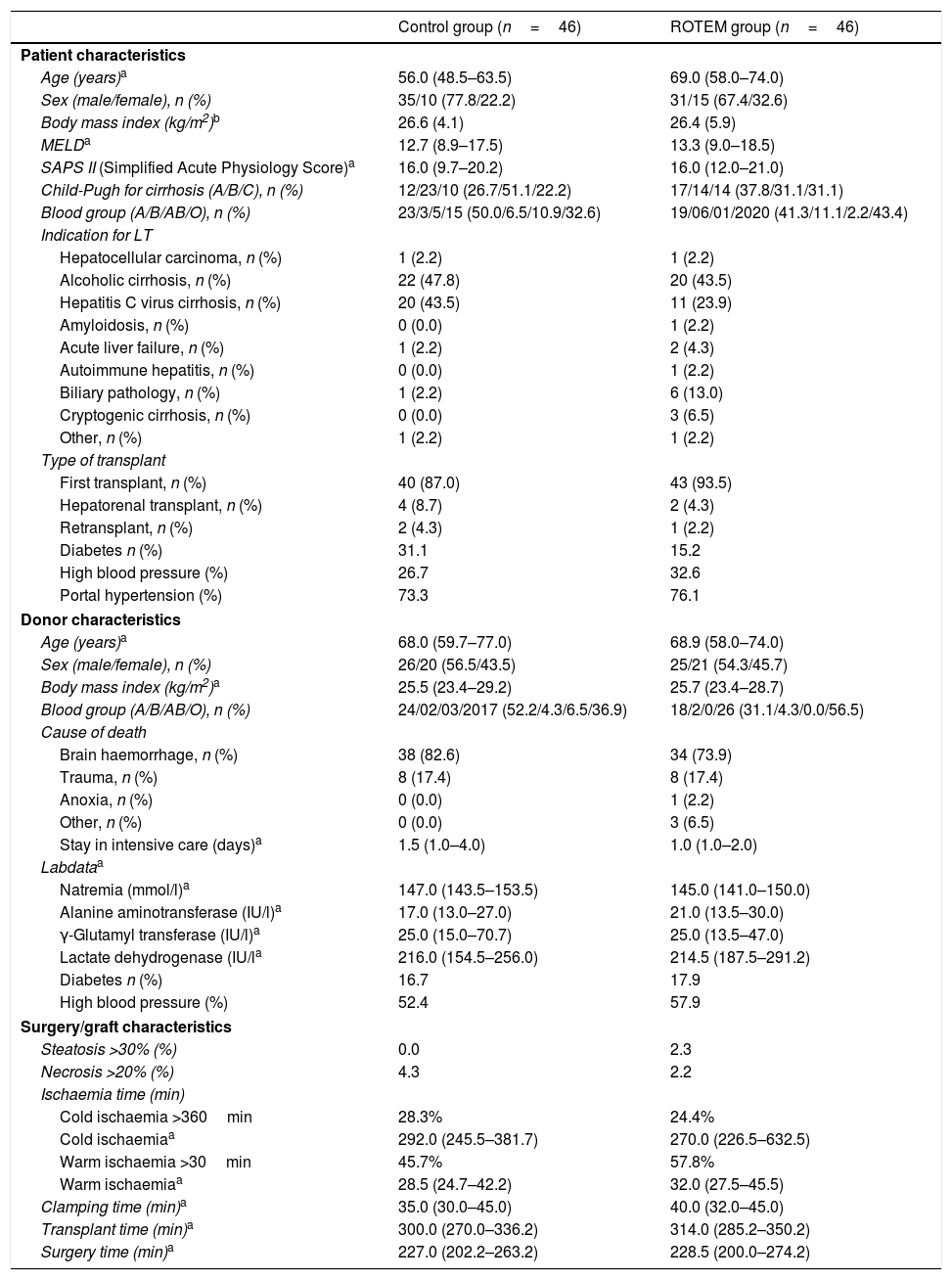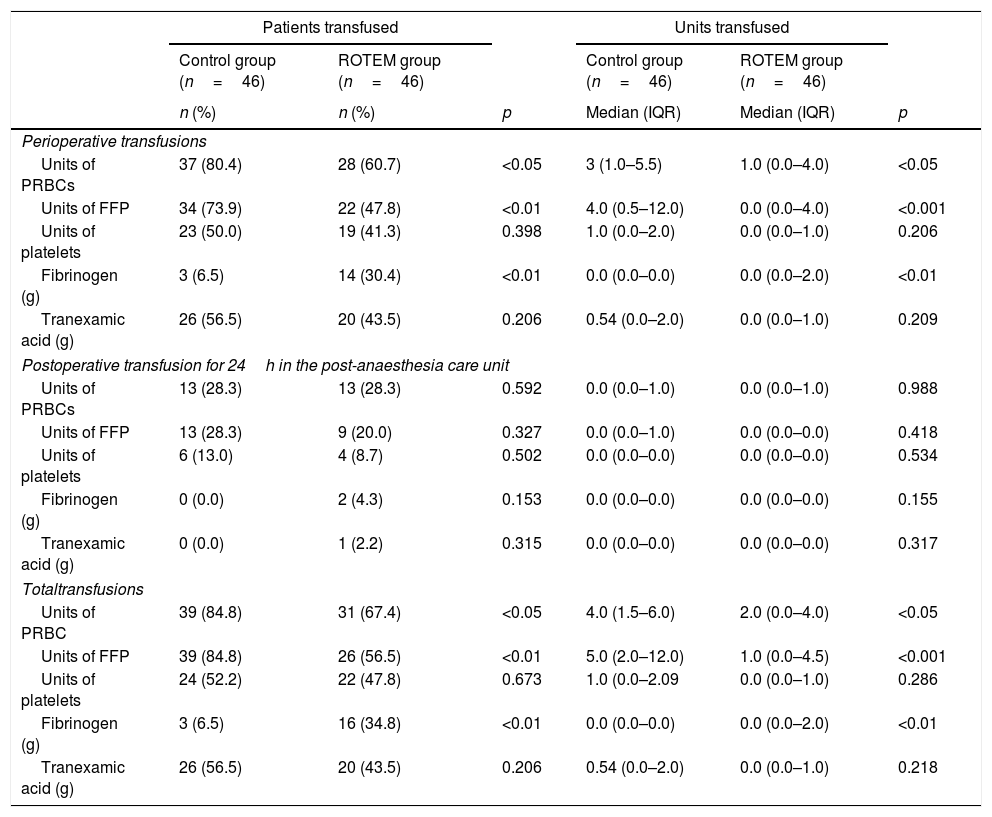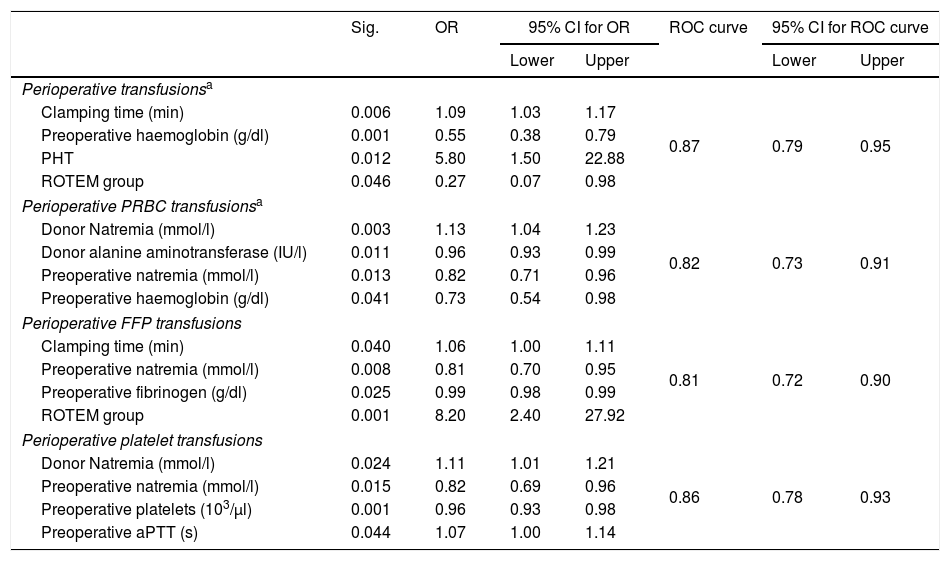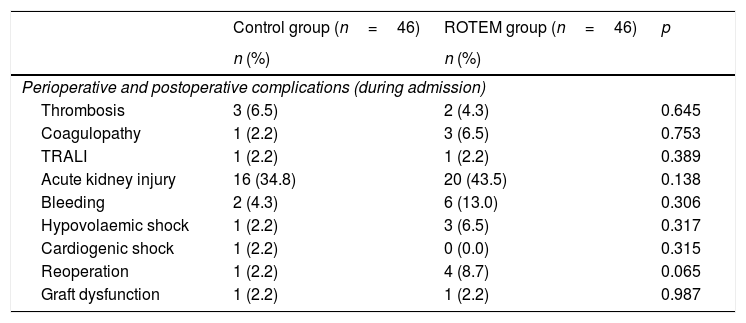Assess the reduction of packed red blood cells (PRBCs) transfusion in liver transplantation (LT) after the introduction of the thromboelastometry as intraoperative coagulation monitor.
MethodsWe conducted a retrospective cohort study (n=92), randomized into two groups: group A (control), in whom transfusion therapy was based on conventional laboratory tests (CLT), and group B (ROTEM), whose blood transfusion was performed as protocolized algorithms, guided by thromboelastometry (ROTEM). We analyzed packed red blood cells (PRBCs) units, transfused units of fresh frozen plasma (FFP), platelets units, fibrinogen and tranexamic acid. We used the Chi square test for the comparison of proportions and Student's t test to compare means when the distribution was normal. Otherwise, Mann–Whitney U test was performed.
ResultsIn group A 84.8% of patients required transfusion of PRBCs, with a median (IQR) of 4 (1.5–6), compared with 67.4% in group B with a median (IQR) of 2 (0–4) (p<0.05). We also found differences in the following variables: FFP transfusion rate was 84.8% with a median (IQR) of 5 (2–12) IU in group A and 56.5% (median (IQR) of 1 (0–4.5) in B (p<0.001) and in the fibrinogen administration, that was 6.5% in group A and 34.8% in group B (p<0.01). Backward stepwise logistic regression model showed associations between the clamping time, the preoperative haemoglobin, the portal hypertension (PHT) and being or not in the treatment group and the need for perioperative transfusion. We did not find significant differences in the incidence of complication during the early postoperative period between the two groups.
ConclusionsThe introduction of thromboelastometry (ROTEM) measurements in hemostatic therapy algorithms reduces the transfusion rate of FFP and PRBCs during liver transplantation. The using of ROTEM derived thresholds leads to detecting higher requirements of fibrinogen compared to conventional laboratory tests.
Evaluar la disminución de la transfusión de concentrados de hematíes en el trasplante hepático después de la introducción de la tromboelastometría como monitorización de la coagulación.
MétodoRealizamos un estudio de cohortes retrospectivo (n=92), aleatorizado en dos grupos. El grupoA (control), en el cual la terapia de transfusión se basaba en las analíticas convencionales, y el grupoB (ROTEM). Analizamos la transfusión de unidades de concentrado de hematíes, plasma fresco congelado, unidades de plaquetas, así como el uso de fibrinógeno y ácido tranexámico. Usamos el test chi cuadrado para la comparación de proporciones y el test t de Student para la comparación de medias cuando la distribución era normal, y cuando no lo era, el test U de Mann-Whitney.
ResultadosEn el grupoA, el 84,8% de los pacientes requirieron una transfusión de concentrado de hematíes, con una media de4 (1,5-6), comparado con el 67,4% en el grupoB, con una media de 2 (0-4) (p<0,05). También encontramos diferencias en las siguientes variables: la transfusión de plasma fresco congelado fue del 84,8%, con una media de 5 (2-12) unidades en el grupoA y el 56,5% de pacientes fueron transfundidos con una media de 1 (0-4,5) en el grupoB (p<0,001). Respecto a la administración de fibrinógeno, fue del 6,5% en el grupoA y del 34,8% en el grupoB (p<0,01). El modelo de análisis multivariante nos muestra la asociación existente entre el tiempo de clampaje, la hemoglobina preoperatoria, la hipertensión portal y estar o no en el grupo tratamiento con la necesidad de transfusión perioperatoria. No encontramos diferencias estadísticamente significativas en la incidencia de complicaciones en el postoperatorio inmediato en los dos grupos.
ConclusionesLa introducción de un algoritmo basado en la tromboelastometría (ROTEM) en el trasplante hepático reduce la tasa de transfusión de concentrado de hematíes y plasma fresco congelado. El uso de los puntos de corte derivados de la tromboelastometría nos conduce a detectar mayores requerimientos de fibrinógeno comparado con los análisis de laboratorio convencionales.












